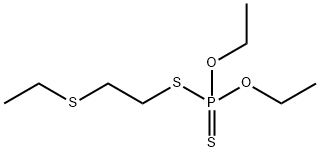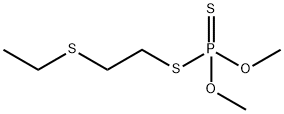DISULFOTON
- CAS NO.:298-04-4
- Empirical Formula: C8H19O2PS3
- Molecular Weight: 274.4
- MDL number: MFCD00036234
- EINECS: 206-054-3
- SAFETY DATA SHEET (SDS)
- Update Date: 2024-12-18 14:08:52

What is DISULFOTON?
Description
Disulfoton is a combustible, colorless toyellowish oil with a characteristic odor. Technical productis a brown liquid. Molecular weight= 274.42; Boilingpoint= 132133℃ at 1.5 mm pressure; Freezing/Meltingpoint $ 225℃; Vapor pressure= 0.0002 mmHg at 20℃;Flash point=82℃. Hazard Identification (based on NFPA704 M Rating System): Health 4, Flammability 1,Reactivity 0. Practically insoluble in water;solubility 5 0.003% at 25℃
Chemical properties
Disulfoton is a dark yellowish oil with an aromatic, sulfurous odor. It is soluble in most organic solvents and fatty oils. Disulfoton is a selective, systemic insecticide and acaricide. It is used for seed coating and for soil application to protect from insect attacks, for the control of sucking insects, aphids, leaf hoppers, thrips, beet-fl ies, spider mites, and coffeeleaf miners. Disulfoton has been used extensively in pest control on a variety of crops, such as cotton, tobacco, sugar beets, corn, peanuts, wheat, ornamentals, cereal grains, and potatoes. It is grouped by the US EPA under RUP. Human exposures to disulfoton occur through breathing contaminated air, drinking contaminated water, eating contaminated food, and working in industries that manufacture and formulate the pesticide.
The Uses of DISULFOTON
DISULFOTON is used as systemic insecticide and acaracide.
The Uses of DISULFOTON
Systemic insecticide and acaricide for control of sucking insects and mites in fruits, vegetables, cotton and forestry nurseries.
The Uses of DISULFOTON
Disulfoton is used to control sucking insects and mites in a wide range of crops.
Definition
ChEBI: An organic thiophosphate that is the diethyl ester of S-[2-(ethylsulfanyl)ethyl] dihydrogen phosphorodithioate.
General Description
Disulphoton is a dark yellowish oil with an aromatic, sulphurous odour. It is soluble in most organic solvents and fatty oils. Disulphoton is a selective, systemic insecticide and acaricide. It is used for seed coating and for soil application to protect from insect attacks and for the control of sucking insects, aphids, leafhoppers, thrips, beetflies, spider mites, and coffee-leaf miners. Disulphoton has been extensively used in pest control on a variety of crops such as cotton, tobacco, sugar beets, corn, peanuts, wheat, ornamentals, cereal grains, and potatoes. It is grouped by the U.S. EPA under RUP. Human exposures to disulphoton occur through breathing contaminated air, drinking contaminated water, eating contaminated food, and working in industries that manufacture and formulate the pesticide.
Reactivity Profile
Organothiophosphates, such as DISULFOTON, are susceptible to formation of highly toxic and flammable phosphine gas in the presence of strong reducing agents such as hydrides. Partial oxidation by oxidizing agents may result in the release of toxic phosphorus oxides.
Health Hazard
Highly toxic, may be fatal if inhaled, swallowed or absorbed through skin. Contact with molten substance may cause severe burns to skin and eyes. Avoid any skin contact. Effects of contact or inhalation may be delayed. Fire may produce irritating, corrosive and/or toxic gases. Runoff from fire control or dilution water may be corrosive and/or toxic and cause pollution.
Health Hazard
Disulfoton is highly toxic to animals and humans by all routes of exposures, namely, by dermal absorption, through ingestion, and inhalation by the respiratory route. The symptoms of poisoning include blurred vision, fatigue, headache, dizziness, sweating, tearing, and salivation. It inhibits cholinesterase and affects the nervous system function. It does not cause delayed neurotoxicity. Prolonged period of exposures to high concentrations of disulfoton cause harmful effects to the nervous system with symptoms such as narrowing of the pupils, vomiting, diarrhea, drooling, diffi culty in breathing, lung edema, tremors, convulsions, coma, and death. Disulfoton causes no mutagenic or teratogenic effects in laboratory animals. There are no reports indicating that disulfoton causes cancer in animals or humans. The DHHS, the IARC, and the US EPA have not classifi ed disulfoton as to its ability to cause cancer.
Fire Hazard
Combustible material: may burn but does not ignite readily. Containers may explode when heated. Runoff may pollute waterways. Substance may be transported in a molten form.
Agricultural Uses
Insecticide, Acaricide: All products formulated at greater than 2% disulfoton are classified as Restricted Use Pesticides (RUP). Disulfoton is a selective, systemic organophosphate insecticide and acaricide that is especially effective against sucking insects. It is used to control aphids, leafhoppers, thrips, beet flies, spider mites, and coffee leaf miners. Not approved for use in EU countries. There are 21 global suppliers.
Trade name
BAY 19639®; BAYER 19639®; DIMAZ®; DISULFATON®; DI-SYSTON®[C]; DISYSTON®[C]; DISYSTOX®; DITHIODEMETON®; DITHIOSYSTOX®; EKATIN TD®; FRUMIN-AL®; FRUMIN G®; GLEBOFOS®; M-74®; S 276®; SOLVIREX®; THIODEMETON®; THIODEMETRON®
Safety Profile
Poison by ingestion, inhalation, skin contact, intraperitoneal, and intravenous routes. Human mutation data reported. When heated to decomposition it emits veq toxic SOx and POx. See also various demeton entries and ESTERS.
Potential Exposure
AgriculturalChemical; Mutagen; Human Data. Those involved in themanufacture, formulation, and application of this systemicinsecticide and acaricide.
First aid
If this chemical gets into the eyes, remove anycontact lenses at once and irrigate immediately for at least15 min, occasionally lifting upper and lower lids. Seek medical attention immediately. If this chemical contacts theskin, remove contaminated clothing and wash immediatelywith soap and water. Speed in removing material from skinis of extreme importance. Shampoo hair promptly if contaminated. Seek medical attention immediately. If thischemical has been inhaled, remove from exposure, beginrescue breathing (using universal precautions, includingresuscitation mask) if breathing has stopped and CPR ifheart action has stopped. Transfer promptly to a medicalfacility. When this chemical has been swallowed, get medical attention. Give large quantities of water and inducevomiting. Do not make an unconscious person vomit.Medical observation is recommended following acuteoverexposure.
Environmental Fate
Soil/Plant. Disulfoton was metabolized in soil and plants to the corresponding sulfoxide and sulfone via oxidation of the thioether sulfur atoms (Metcalf et al., 1957; Getzin and Shanks, 1970; Takase et al., 1972; Clapp et al., 1976; Worthing and Hance, 1991), the corresponding phosphorothioate analogs and then to derivatives of O,O-diethyl hydrogen phosphate and 2-ethylthioethyl mercaptan (Worthing and Hance, 1991). Disulfoton is rapidly oxidized in soil to its sulfoxide and sulfone with disulfoton oxon sulfoxide and disulfoton oxon sulfone appearing in small amounts (Szeto et al., 1983). In a Portneuf silt loam soil, the persistence of the sulfoxide and sulfone was 32 and >64 days, respectively (Clapp et al., 1976).
Disulfoton was translocated from a sandy loam soil into asparagus tips. Disulfoton sulfoxide, disulfoton sulfone, disulfoton oxon sulfoxide and disulfoton oxon sulfone were recovered as metabolites (Szeto and Brown, 1982; Szeto et al., 1983). Disulfoton s
Groundwater. According to the U.S. EPA (1986) disulfoton has a high potential to leach to groundwater.
Photolytic. Disulfoton was rapidly oxidized to disulfoton sulfoxide and trace amounts (<5% yield) of disulfoton sulfone when sorbed on soil and exposed to sunlight (half-life 1–4 days) (Gohre and Miller, 1986). The photosensitized oxidation was probably due to the presence of singlet oxygen (Gohre and Miller, 1986; Zepp et al., 1981). The degradation rate was higher in soils containing the lowest organic carbon (Gohre and Miller, 1986). Chemical/Physical. Emits toxic fumes of phosphorus and sulfur oxides when heated to decomposition (Sax and Lewis, 1987; Lewis, 1990).
When fertilizers containing superphosphate and ammonium nitrate were impregnated with disulfoton, the latter chemically degraded to form disulfoton sulfone and disulfoton sulfoxide (Ibrahim et al., 1969).
The reported half-lives for abiotic hydrolysis
Metabolic pathway
Disulfoton is metabolised by an analogous route to phorate. The principal route of disulfoton metabolism in all media is activation via oxidation of the thioether group to the sulfoxide (rapid) and sulfone (slower). Thioether oxidation occurs preferentially to oxidative desulfuration of the P=S group to the oxon, which is usually only present in trace amounts and there is good evidence that the sulfoxide and sulfone oxons arise via disulfoton sulfoxide and sulfone rather than disulfoton oxon. The more polar thiooxidised metabolites are translocated in plants and are responsible for the compound's systemic action.
Metabolism
The metabolic routes of disulfoton are essentially the same in plants, insects, and mammals, involving the oxidation of the sulfide group into the sulfoxide and then sulfone, oxidative desulfuration to the corresponding oxons, and hydrolysis to diethyl phosphorothioate. In mammals, orally administered disulfoton is rapidly metabolized and excreted in the urine. Disulfoton is rapidly degraded in soil; DT50 (20 ?C) was 1.3–2 d.
storage
Color Code—Blue: Health Hazard/Poison: Storein a secure poison location. Prior to working with disulfotonyou should be trained on its proper handling and storage.Store in tightly closed containers in a cool, well-ventilated
Shipping
Organophosphorus pesticides, solid, toxic, n.o.s.require a shipping label of “POISONOUS/TOXICMATERIALS.” They fall in DOT Hazard Class 6.1 andDisulfoton in Packing Group I.
Degradation
Disulfoton is stable at acidic and neutral pH values but it is hydrolysed in alkaline media.
Toxicity evaluation
The acute oral LD50 for rats is 2–12 mg/kg. Inhalation LC50 (4 h) for rats is 0.06–0.015 mg/L air. NOEL (2 yr) for rats is 1 mg/kg diet (0.05 mg/kg/d). ADI is 0.3 μg/kg b.w.
Incompatibilities
Contact with oxidizers may cause therelease of phosphorous oxides. Contact with strong reducingagents, such as hydrides, may cause the formation of flammable and toxic phosphine gas.
Properties of DISULFOTON
| Melting point: | 110-112℃ |
| Boiling point: | bp0.01 108°; bp1.5 132-133° |
| Density | 1.1445 g/cm3 (20 ºC) |
| vapor pressure | 7.2 x 10-3 Pa (20 °C) |
| refractive index | 1.5501 (589.3 nm 20℃) |
| Flash point: | 133 °C |
| storage temp. | 0-6°C |
| form | liquid |
| Water Solubility | 25 mg l-1 (20 °C) |
| Merck | 13,3400 |
| BRN | 1709167 |
| CAS DataBase Reference | 298-04-4(CAS DataBase Reference) |
| EPA Substance Registry System | Disulfoton (298-04-4) |
Safety information for DISULFOTON
| Signal word | Danger |
| Pictogram(s) |
 Skull and Crossbones Acute Toxicity GHS06  Environment GHS09 |
| GHS Hazard Statements |
H410:Hazardous to the aquatic environment, long-term hazard |
| Precautionary Statement Codes |
P262:Do not get in eyes, on skin, or on clothing. P264:Wash hands thoroughly after handling. P264:Wash skin thouroughly after handling. P273:Avoid release to the environment. P280:Wear protective gloves/protective clothing/eye protection/face protection. P301+P310:IF SWALLOWED: Immediately call a POISON CENTER or doctor/physician. |
Computed Descriptors for DISULFOTON
New Products
Tert-butyl bis(2-chloroethyl)carbamate 4-Methylphenylacetic acid N-Boc-D-alaninol N-BOC-D/L-ALANINOL 3-Morpholino-1-(4-nitrophenyl)-5,6-dihydropyridin- 2(1H)-one Furan-2,5-Dicarboxylic Acid Tropic acid 1,1’-CARBONYLDIIMIDAZOLE DIETHYL AMINOMALONATE HYDROCHLORIDE R-2-BENZYLOXY PROPIONIC ACID 1,1’-CARBONYLDI (1,2-4 TRIAZOLE) N-METHYL INDAZOLE-3-CARBOXYLIC ACID (2-Hydroxyphenyl)acetonitrile 4-Bromopyrazole 5-BROMO-2CYANO PYRIDINE 5,6-Dimethoxyindanone 5-broMo-2-chloro-N-cyclopentylpyriMidin-4-aMine 2-(Cyanocyclohexyl)acetic acid 4-methoxy-3,5-dinitropyridine 2-aminopropyl benzoate hydrochloride 1-(4-(aminomethyl)benzyl)urea hydrochloride diethyl 2-(2-((tertbutoxycarbonyl)amino) ethyl)malonate tert-butyl 4- (ureidomethyl)benzylcarbamate Ethyl-2-chloro((4-methoxyphenyl)hydrazono)acetateRelated products of tetrahydrofuran








You may like
-
 Disulfoton CAS 298-04-4View Details
Disulfoton CAS 298-04-4View Details
298-04-4 -
 1975-50-4 98%View Details
1975-50-4 98%View Details
1975-50-4 -
 2-HYDROXY BENZYL ALCOHOL 98%View Details
2-HYDROXY BENZYL ALCOHOL 98%View Details
90-01-7 -
 2-Chloro-1,3-Bis(Dimethylamino)Trimethinium Hexafluorophosphate 221615-75-4 98%View Details
2-Chloro-1,3-Bis(Dimethylamino)Trimethinium Hexafluorophosphate 221615-75-4 98%View Details
221615-75-4 -
 61397-56-6 CIS BROMO BENZOATE 98%View Details
61397-56-6 CIS BROMO BENZOATE 98%View Details
61397-56-6 -
 14714-50-2 (2-Hydroxyphenyl)acetonitrile 98+View Details
14714-50-2 (2-Hydroxyphenyl)acetonitrile 98+View Details
14714-50-2 -
 118753-70-1 98+View Details
118753-70-1 98+View Details
118753-70-1 -
 733039-20-8 5-broMo-2-chloro-N-cyclopentylpyriMidin-4-aMine 98+View Details
733039-20-8 5-broMo-2-chloro-N-cyclopentylpyriMidin-4-aMine 98+View Details
733039-20-8